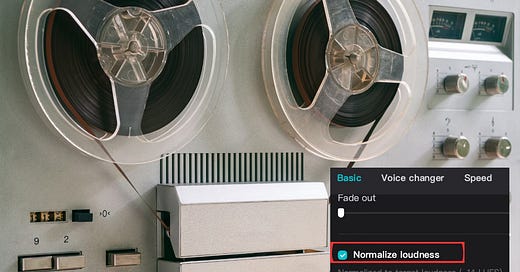Unreeling the Past: My Adventure in Audio Normalization
How I turned up the sound on an old audio file and heard my mother's voice.
My cousin Jo found some old reel-to-reel tapes in a box.
She thought, "Well, probably nothing on there. Who knows?"
But she sent them off to be digitized, got them back, and wow, was that my aunt's much younger voice? Tiny cousins? My mom? It was a little hard to tell, because no matter how far we turned up the volume, everything was really quiet.
These were sitting in a box for years, but of course, when they came back last week, we needed to hear them RIGHT NOW.
I'm not an audio engineer. I can't fix big problems. But from editing videos, I've learned how to fix little things, so I pulled this into CapCut and clicked the button for "Normalize Audio."
Now, I realize CapCut is video editing software, but many video editing apps can also handle small audio tasks like this.
And so can free audio software like Audacity and Garageband. And then there is my favorite online option for audio cleanup over at auphonic.com. It will process up to two hours of audio for free.
When you normalize audio, you’re adjusting the overall volume to a standard level without distorting the sound.
This is useful when the whole recording is just plain too quiet. If you have specific spots that are way softer than the rest, you may still need to select those and amplify them using different features in the software. I don’t think I need to do that, but later, I might want to work on getting rid of some humming noise in the background. Not right now, though. Right now I just want to hear clearly enough to identify who is speaking, and singing, and is that crying I hear?
Here's a quick sample, before normalizing:
And after:
After we normalize, we can make out my mother’s voice. This is June of 1954, almost exactly 70 years ago. She’s singing little songs with two cousins. Apparently their older sister is sick with the measles, and their little brother is not very happy. I wonder if my aunt called and said, “Please, come over and help entertain the kids!”
It’s the only recording I have of Mom’s voice, so... I'm kind of happy for that “normalize” button.
When I was reading up on this feature, I found that different online platforms prefer to have their audio files normalized at different levels. For instance, YouTube seems to prefer the volume a little louder than some of the podcast platforms. When professionals explain this, they use terminology like "-14 LUFS."
That's fancy engineer talk.
I won’t even try to explain it, because when they say things like, “audio that is mastered with a perceived loudness advantage” I begin to get dizzy. (Don’t LUF at me!) For this adventure, I chose the “YouTube” LUFS in CapCut, but I think most default settings in most applications would be just fine.
I'm going to go now, drink some coffee, and listen to my mom help entertain my cousins.
It’s the kind of favorite hit that only family will truly enjoy. For me, today, it's more than just a trip down memory lane — it's like time travel.





Oh, Nancy, you've brought me to tears. For another piece I'm writing about "private podcasts" (probably out next week) I was just exploring old iPhone voice memo recordings caught while driving my mom around in her last months with dementia.
She loved to go for these rides because she could converse with out really conversing. "Look, not a cloud in the sky," or "this looks familiar, have we been here before?" (Favorite phrases she repeated so often.... within minutes of each other on a road we took every day for probably 7 years. 🥹) I'll give this nifty little tool a try. I figured there had to be something out there. Thank you so much.
I absolutely love this even thought it is not my family!! This is the coolest little time travel find 📽️
I have old movies of my mom & dad and grandparents--even my parents' wedding from 1950, but there is no audio at all. I would love to hear something like what you found.